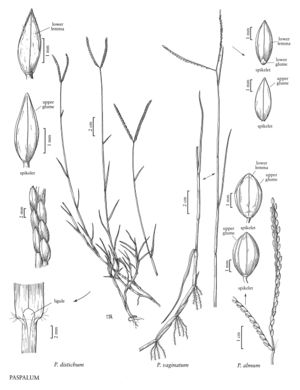Paspalum almum
Plants perennial; cespitose, shortly rhizomatous. Culms 10-50 cm, erect. Sheaths glabrous or sparsely pubescent; ligules 0.5-2 mm; blades to 20 cm long, 1.5-3.8 mm wide, flat, pubescent. Panicles terminal, usually composed of a digitate pair of branches, 1-5 additional branches sometimes present below; branches 1.8-7.1 cm, diverging to erect; branch axes 0.8-1.3 mm wide, winged, terminating in a spikelet. Spikelets 3-3.6 mm long, 1.3-1.8 mm wide, solitary (rarely paired), appressed to the branch axes, elliptic, glabrous, apices acute to acuminate. Lower glumes absent; upper glumes and lower lemmas glabrous, 5-veined, margins flat; upper florets stramineous to golden brown. 2n = 12, 24, 36.
Discussion
Paspalum almum was probably introduced to North America as a forage species. Its native range is Brazil, Paraguay, Uruguay, and eastern Argentina. It has not been reported from Mexico or Central America. In the Flora region, it is found along roadsides and in pastures of southeastern Texas and southern Louisiana.
Selected References
None.
